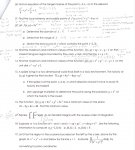f(x,y) = xy -x -y -1 on the closed triangular region bounded by the x-axis and y-axis and the line x + y = 3.
I found a critical point by setting f partial dx and f partial dy each to zero.
x=1 and y=1. (1,1)
f(1,1) = 2
Beyond that, I don't know where to go with these problems. I can admit I'm almost clueless. Thanks for any help.
Would I use a Lagrange multiplier for #16?
I'm also not sure how to do the change of limits when I change to polar coordinates. I know the x = r cos theta, y = r sin theta, etc., but sometimes graphing isn't feasible to determine the theta values.
I found a critical point by setting f partial dx and f partial dy each to zero.
x=1 and y=1. (1,1)
f(1,1) = 2
Beyond that, I don't know where to go with these problems. I can admit I'm almost clueless. Thanks for any help.
Would I use a Lagrange multiplier for #16?
I'm also not sure how to do the change of limits when I change to polar coordinates. I know the x = r cos theta, y = r sin theta, etc., but sometimes graphing isn't feasible to determine the theta values.

